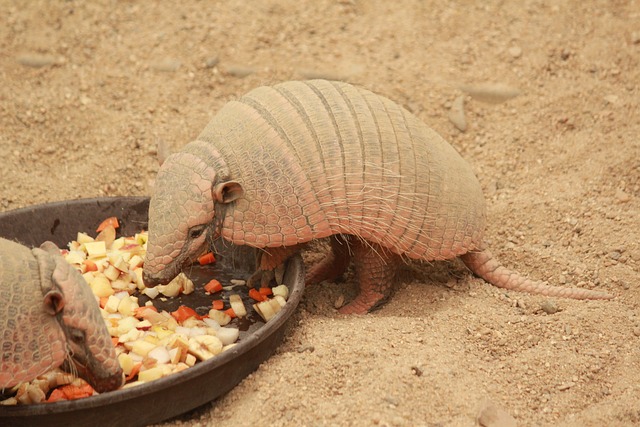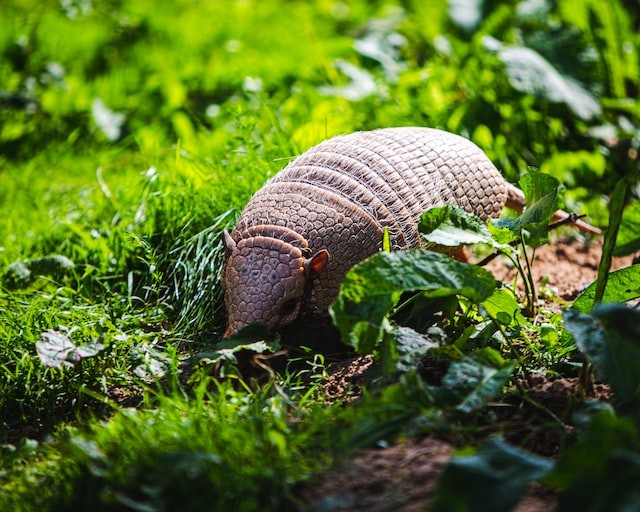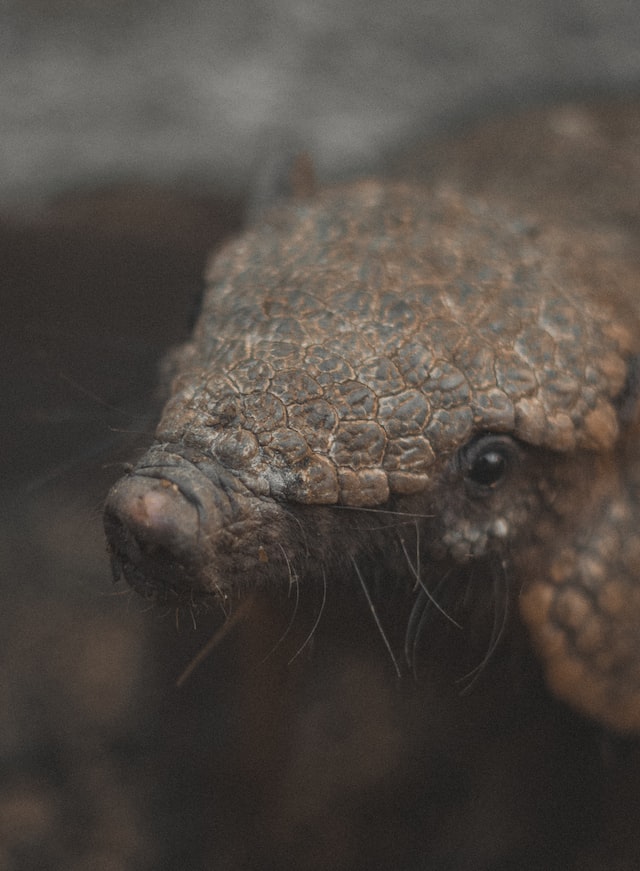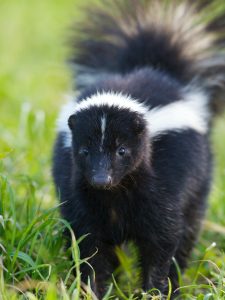ARMADILLO FACTS

Armadillos are unique, small mammals that are native to the Americas. Armadillo is from the Spanish, meaning “little armored one.” The term “armored one” refers to the bony plates that cover most of these odd-looking creatures’ backs, heads, legs, and tails. Most armadillos have this hard shell of bone protecting them from predators and the elements, but not all have this type of armor.
Armadillo species
There are nine distinct species of armadillos, each with its own set of exceptional traits and adaptations.
Nine-banded armadillo
The most well-known species is the nine-banded armadillo, which can be found throughout much of the southern United States, Mexico, and Central and South America. It is also the species most often found in the United States.
The nine-banded armadillo is famous for its ability to curl into a ball for protection, but it also possesses other remarkable adaptations. For instance, it has a strong sense of smell that it utilizes to locate food. It is also an outstanding digger, capable of easily tunneling through soil and even concrete. Furthermore, it has a tough, leathery hide that protects it from predators and helps it retain moisture in arid environments.
Six-banded armadillo
Another species of armadillo is the six-banded armadillo, which resides in the Amazon basin of South America. This species features six bands of armor that are slightly wider than those of the nine-banded armadillo, and it has a long, pointed snout that it uses to dig for food. It is also an excellent swimmer, capable of holding its breath for several minutes underwater.
Giant armadillo
The giant armadillo is the largest of all the armadillo species and is most prominent in the forests and grasslands of South America. It can weigh up to 140 pounds and measure over four feet in length from head to tail. It is also known for its powerful claws, which it uses to dig burrows up to 20 feet deep. Unfortunately, this species is currently listed as vulnerable due to habitat loss and hunting.
Apart from the giant, nine-banded, and six-banded armadillos, six other species are found in different parts of the Americas.
Pink fairy armadillo
One unique species is the pink fairy armadillo, which is found in Argentina. It has a soft, velvety coat with a pale pink or yellowish coloration, and it is an excellent burrower that uses its sharp claws to dig tunnels in the sand. The southern long-nosed armadillo is another species found in South America, with a long, narrow snout that it uses to search for insects and invertebrates in the soil. It also has sharp claws for digging and self-defense.
Screaming hairy armadillo
The screaming hairy armadillo, found in Bolivia, Paraguay, and Argentina, is known for its loud, high-pitched vocalization and a thick fur coat that keeps it warm in colder climates. The Andean hairy armadillo, found in the Andes Mountains of South America, has a thick coat of fur that helps it withstand the cold temperatures at high altitudes. It is also a skilled climber, using its sharp claws to climb trees and find food.
Three-banded armadillo
The three-banded armadillo, found in Brazil, has a unique feature: it can roll into a tight ball to protect itself from predators. The northern naked-tailed armadillo, found in Mexico and Central America, lacks armor on its tail and uses its flexible tail to hold onto branches while searching for food. Each armadillo species has adapted to its unique environments in fascinating ways, making them a vital part of the natural world.
So, what do these unique creatures eat?

Armadillo diet
Armadillos are nocturnal animals and are usually active and hunt for food at night. Their long tongues help them to capture their prey.
INSECTS: THE MAINSTAY OF THE ARMADILLO DIET
Armadillos are primarily insectivores but also consume grubs, invertebrates, and small vertebrates. Their diet is comparable to that of hedgehogs!
PLANTS: ARMADILLOS ARE NOT JUST OPPORTUNISTIC FEEDERS
Armadillos have a low metabolic rate, which means they need to eat less food than other mammals of the same size. They can also survive on various plant materials, including fruit and vegetables. But their diet consists of more than that!
OTHER ANIMALS: WHAT ELSE DO ARMADILLOS EAT? Do armadillos eat snakes too?
Armadillos also eat the meat of small animals, including reptiles like snakes and even eggs that they can find.
In captivity, armadillos can be fed a diet of ground beef, fruits, and vegetables. It is important to provide them with a well-rounded diet that includes all the nutrients they need to stay healthy.

Armadillo’s diet by species
Armadillos are fascinating creatures with unique dietary requirements and specialized adaptations. Each species has distinct dietary preferences and feeding behaviors that set them apart from one another.
Nine-banded armadillos
The nine-banded armadillo is an omnivore, consuming a diverse range of foods. Its diet includes insects, such as ants and termites, small animals, like snails and bird eggs, and fruits and vegetables. They are opportunistic in their food choices and will eat whatever is readily available.
Six-banded armadillos
The six-banded armadillo is an insectivore that primarily feeds on ants and termites. However, it also consumes small vertebrates and fruits depending on the availability of food. The narrow snout of this species makes them well-equipped to forage in little crevices in the soil.
Three-banded armadillos
Three-banded armadillos, another insectivorous species, consume termites and ants almost exclusively. They have a keen sense of smell, which helps them locate their prey. Due to their unique ability to roll into a tight ball, they can forage in areas with high concentrations of termites and ants.
Giant armadillos
Giant armadillos are omnivorous, consuming a mix of plant and animal matter. Their diet includes termites, ants, beetle larvae, small vertebrates, fruits, and other plant matter. This species’ large size and powerful claws make them capable of digging through tough soil to access their prey.
Pink fairy armadillos
Pink fairy armadillos are insectivores, primarily feeding on ants, termites, and other small invertebrates. Their strong claws enable them to burrow into the ground to find food. Due to their small size, their diet is limited, and they lack specialized teeth for chewing.
Screaming hairy armadillos
Screaming hairy armadillos are omnivores, consuming insects like ants, beetles, and termites, small vertebrates like rodents and lizards, and fruits and seeds. They rely heavily on insects for their nutrition, but their diet is less specialized than other armadillo species.
Armadillos have unique dietary requirements, and as a result, each species has evolved specific adaptations to meet these needs.
Their diets range from specialized insectivores to omnivores that consume both animal and plant matter. These diverse feeding behaviors are critical in maintaining the balance of their ecosystems.

Animal Food Chain: What Role Do Armadillos Play?
Armadillos play a crucial role in the animal food chain, occupying different positions depending on their diets and habitats. As an omnivore, the nine-banded armadillo is classified as a secondary consumer. It feeds on small animals, insects, and plants, making it an essential predator in its ecosystem. Similarly, the giant armadillo, which feeds on insects and invertebrates, is also a secondary consumer.
In contrast, armadillos that consume plants primarily, such as the three-banded armadillo, are considered primary consumers. By eating insects that feed on plants, these armadillos play a critical role in maintaining plant diversity in their ecosystems.
Armadillos also serve as seed dispersers, consuming fruit and spreading seeds throughout their habitats. This helps to maintain the overall health and diversity of the ecosystem.
However, armadillos are also preyed upon by various predators, including wildcats, birds of prey, and domestic dogs. When hunted, armadillos become part of the food chain as prey.
In conclusion, armadillos occupy different positions in the animal food chain, depending on their diet and role in their ecosystem. They serve as essential predators, prey, and seed dispersers, contributing to the health and balance of their environments.
What attracts armadillos to your yard?
Armadillos can be attracted to yards and gardens for various reasons, primarily related to food and habitat. Some common factors that can lure armadillos into your yard include the following:
- Food: Armadillos are insectivores, so if your yard has abundant insect populations, such as beetles, ants, and termites, it may attract them. They may also eat fruits and vegetables, so if your garden has ripe fruit, it can appeal to armadillos.
- Water: Armadillos need a regular water source, so if your yard has a water source, such as a pond or fountain, it may attract them.
- Shelter: Armadillos prefer areas with cover and protection, such as thick vegetation or piles of leaves or brush. If your yard has areas with dense vegetation or piles of leaves, it may provide attractive shelter for armadillos.
- Soil: Armadillos are skilled diggers and will often hunt for insects and other prey in the soil. Loose or sandy soil in your yard may make it more attractive to armadillos.
- Landscaping: Armadillos may be attracted to certain types of landscaping, such as mulched areas, flower beds, and vegetable gardens.
To discourage armadillos from entering your yard, you can take several steps. For instance, you can remove potential food sources, such as insects and fruits, and eliminate areas of dense vegetation or piles of leaves. You can install a fence around your property to keep armadillos out or use motion-activated sprinklers to scare them away. Additionally, if you have a water source in your yard, consider draining it or covering it up to discourage armadillos from using it as a regular water source.






